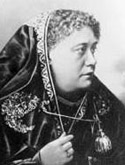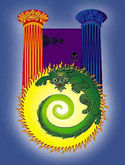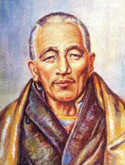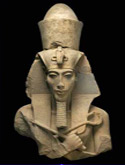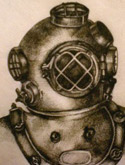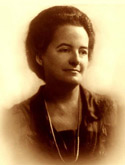John Pierpont Morgan: Financier, Art Collector, Reorganizer of American Corporate Structures
(1837-1913) April 17, 1837, Hartford, Connecticut. 3:00 AM LMT (from his grandfather’s diary); 1:10PM, LMT.
(Source: Evangeline Adams, astrologer to Morgan) Died, March 31, 1913, 00:30 AM, in Rome, Italy.



(Ascendant in the chosen chart, Aquarius with MC in Sagittarius; Ascendant in the rejected Evangeline Adams chart, chart, Leo with MC in Taurus; Sun in Aries conjunct Mercury and Ceres in Aries, with Venus and Pluto also in Aries and conjunct; Moon in Virgo ; Mars and Jupiter in Leo, conjuncted; Saturn in Scorpio; Uranus in Pisces; Neptune in Aquarius; NN conjunct in Taurus;)

John Pierpont Morgan was one the most powerful financiers of the later nineteenth and early twentieth In an era known for socially irresponsible “robber barons”, he amassed a tremendous fortune as a banker, a builder of railroads, and reorganizer of the steel, electric and telephone industries. Interestingly, he was a major source of support to Thomas Edison and Nicola Tesla. For many years he and a small but immensely wealthy oligarchy ruled over America’s major corporations, railroads, insurance companies, securities markets, and banks. He had a passion for organizing and reorganizing industrial trusts creating giant conglomerates such as U.S. Steel, General Electric and International Harvester.
He was, in a sense, the “unofficial central banker” of the USA before there was a Federal Reserve and single-handedly saved the United States from bankruptcy on two occasions. He regarded coming to the “rescue” of his country in such emergencies – providing the desperate United States government with huge sums it needed to continue its operations – simply as his “providential duty”. Of course he profited handsomely from these gestures of largesse and his reputation as a benefactor of America rose in the eyes of millions. For such admirers he became a economic “saint”; for others he was a grasping “demon”. He received an honorary degree from Harvard University that read: “Public citizen, patron of literature and art, prince among merchants, who by his skill, wisdom and courage, has twice in times of stress repelled a national danger of financial panic.” There was much truth in these laudatory phrases, but there was also another side to the story. Robert LaFollette, the Wisconsin progressive, saw him as “a beefy, red-faced thick-necked financial bully, drunk with wealth and power”.
A Few Points Concerning the Chart Chosen
a. We have an interesting situation with regard to J.P. Morgan’s astrological chart. An entry in his grandfather’s diary reports a time of birth of 3:00 AM. Normally, this would be a good starting point and could be judged as reasonably reliable.
b. But Morgan (apparently believing in the value of astrology) was a client of one of the world’s most renowned astrologers, Evangeline Adams, who, for whatever reasons, rectified his astrological chart to 1:10 PM, a jump forward of some ten hours. Probably, she saw the power of Leo in his chart and thought that his obvious Leonian strength required a Leo Ascendant. Of course, his exoteric ruling planet Mars (ruler of the Aries Sun) is found in Leo conjunct Jupiter, also in Leo. This would provide a great deal of the Leo energy, so there would be no necessary recourse to such a drastic rectification (unless other reasons entered into the consideration). Because the Leo Ascendant chosen by Adams was pretty much opposite the degree of Aquarius rising in the chart based on Morgan’s grandfather’s time, aspects and eclipses relating to one of the horizon’s “angles” would relate to the other, and the astrologer could, thereby, be deceived.
c. Ironically, Evangeline Adam’s own Ascendant is unverified (at least in the estimation of Lois Rodden) and, the two signs considered as possible Ascendant’s for J. P. Morgan (Aquarius and Leo) are, respectively, the Sun-sign and Moon-sign of Evangeline Adams. There was definitely a connection between the two of them. Adams’ Moon was conjunct the Leo Ascending degree she proposed for Morgan, and her Aquarius Sun was within a wide conjunction of the Ascendant resulting from the use of the grandfather’s 3:00 AM time. It seems rather certain that the Aquarius-rising chart is the correct one. If it is, there may be a lesson for all of us. Where there is confusion about one’s own identity, that confusion may make it difficult for us to correctly see the identity of others. Evangeline Adams chose Pisces as her Rising-sign – reasonable enough, given her great intuitive abilities. Pisces, itself, is a sign frequently involved in confusion. Adams’ chart is fascinating, but one must be wary about using it because she gave different years of birth on different occasions.
d. The 3:00 AM time is here accepted as relatively valid. A slight rectification is proposed, using a time of birth of 3:02:38 AM (give or take some seconds). This time advances the Ascendant by about a degree and the MC as well, which fits well with certain Solar Arc directions (SADs) at the time that Morgan met his first wife, with whom he was deeply in love.
A Few Points Concerning Physiognomy
a. Some of the photographs of J. P. Morgan are very different from each other. This is understandable for two reasons.
b. As a young man he was what most would judge as handsome. In middle age, he suffered from an inherited skin disease (Chiron at the fourth house of inherited karmic conditions) called rhinophyma, which caused a deformity to his nose, called “a hideous deformity”. Thus, his appearance in later years is much altered from earlier photographs.
c. It is likely, as well, that the disfiguration caused by the disease aroused in him a self-protective, psychological compensation, perhaps an even more aggressive and intimidating bearing.
d. In the case of Morgan, the signature of Aries is an intense and penetrating stare and a strong concentration of energy where the brows come together. He was possessed of a “self enclosed intensity” upon which everyone seemed to remark – a quality typical of the first ray.
e. The frontal baldness is sometimes found with Aries (at least a thinning of the hair in front), but with Leo it is frequently found. We must remember that the position of the planet which rules the Sun (the exoteric ruler, when it comes to physiognomy) and the exoteric ruler of the Ascendant are both powerful physiognomical indicators. Mars in Leo is, for Morgan, a tremendous indicator and adds to his commanding presence.
f. Later, according to one photographic image at least, he shaved his head. This added to his imposing appearance. One knew that one was in the presence of power.
g. There was a more feminine, Venusian aspect to his character – more passive – and one sees this in only one of the collected images, the image of Morgan when still a relatively young man.
h. Some of the usual indicators of Aquarius – early graying, bristling hair and what might appear as “electric curls”, nervous manners, cannot here be determined. Nor does Aquarius stamp its “natives” with features as remarkable as in some other signs.
i. We do know that Morgan could not stand to be alone (a trait of many Aquarians, especially before they have learned introspection). He led a frenetic social life and frequently suffered from bouts of depression (a trait upon which the Tibetan Teacher comments in relation the Aquarian character). (EA 141-142)
j. He also suffered from a number of strange, nervous disorders (exacerbated after the death of his first wife). These, too, may implicate Aquarius and very probably, Uranus, which is in the first house of the proposed chart, placed in the obscuring and indefinite sign Pisces.
k. It should also be realized that if the birth time is advanced by less than seven minutes, the Ascendant changes to Pisces, a sign of passivity compared with sometimes blustering Aries/Leo. There was a well-hidden Neptunian/Venusian side of Morgan’s character, his gruff exterior notwithstanding.
Examining the Rays of J. Pierpont Morgan
a. Judging from his life and appearance, the rays which dominate are the first and the third. It is difficult to tell which might be the soul ray and which the ray of the personality. His focus was the field of business and he was surely what the Tibetan would call an “advanced man” – whether or not one could call him an aspirant. The business field is frequently “populated” by souls focussing on the third or seventh ray. One can fairly easily dismiss the prominence of the seventh ray in Morgan’s case (although he was a powerful organizer, and rising Uranus would make this ray accessible) largely because of his individualistic attitudes and aggressiveness. The third ray is surely the greater possibility as he was a great manipulator of immense wealth and was forever planning and scheming in relation to new enterprises.
b. This ray of what might be called “intelligent materialism” emerged early in his life. As a natural born financier, Morgan, the teenager, loved spreading his bank account among dozens of different foreign currencies, and he even devised a mock trading and investment banking “game” with his cousin. This was a harbinger of things to come and is an entirely third ray activity. He spent so much of his life “wheeling and dealing” with huge sums at stake. Always looking for a better bargain, He was intimately related to the third ray Law of Economy.
c. As well, we simply must include the first ray of Will and Power. Everything about his presence is commanding (whether or not part of his stance is compensatory). Everyone compensates, but first ray types are adept at using power compensatorily. His powerful Aries Sun-sign, ruled by assertive/aggressive Mars placed in the first ray sign, Leo, gives a very significant inlet for first ray energies. So does Uranus rising.
d. Taken together he has four planets and the asteroid, Ceres, in ray one Aries, and two planets in ray one Leo. This makes six of the usual planets in first ray signs (along with the other rays these signs transmit). First ray Capricorn is not tenanted, but Saturn, the ruler of Capricorn, must be significant in someone with so much third and first ray..
e. The conventional inlets for the third ray are not so many. In fact, none of the third ray signs are represented. However, a soul upon the third ray would naturally express through the planets associated with that ray – in this case Saturn and the Earth.
f. Saturn is in the power-accumulating sign Scorpio (the sign associated with the act of “cornering the market” or monopolizing), and third ray Earth, heliocentrically, would be placed in third ray Libra in house eight, archetypally ruled by Scorpio.
g. Morgan’s love of art and the more tender aspects of his character point to the need for a soft-line ray somewhere. It may be that fourth ray was the ray of the mental body (though much first ray seemed to be present in his rather laconic pronouncements). Fourth ray Mercury, esoteric ruler of his Aries Sun is placed in Aries, and pressureful Saturn in struggling Scorpio (especially if Saturn is the “ray-ruler” of his soul) would provide plenty of conflict. We must account for Morgan’s relationship to art. Financially the motives are obvious. It is important to assess the depth of his aesthetic relationship as well. He is said to have loved art, though he could not really “speak” of it.
h. The astral body cannot be the second. The sixth is far more probable and suggested by the configuration of Neptune in the twelfth house opposed the Mars/Jupiter conjunction in the sixth. Morgan, as his father before him, conceived himself a patriot, and proved his patriotism (financially) on a number of occasions. In his eyes great wealth was nothing to be ashamed of and he used it, so he would say, to build his nation and sustain its prosperity. Jupiter/Mars oppose Neptune definitely signals idealism rather than cynicism (despite the economic “hard ball” he undoubtedly played as a preeminent “robber baron” of his day).
i. The physical body is probably the third, although there is a very close sextile between Saturn in Scorpio and the Moon in Virgo, an aspect which would confer some precision and exactitude on the physical plane. He did begin his work as an accountant.
j. So, then, fundamentally, was J. P. Morgan focussed upon the first ray in his soul nature or the third? Either is possible and every profession is filled with those upon all the rays. These AAB’s words: “People of all kinds and professions are found on all the rays”. (DINA I xiv) Further, from the Tibetan: “The artist is found on all rays, just as is the engineer or the physician, the home-maker or the musician. I want to make this clear, for there is much misunderstanding on this matter”. (EP I 49) Also: “The creative artist is found equally on all rays, without exception.” (EP II 41)
k. Morgan was a great “tycoon”. His expression of the first ray was undeniable. But was it his deepest motive? Was it the “end” or the “means”? Further, did the third ray appear to be the ray of the personality, for it would surely have to be if the first ray were his soul ray? To conceive of Morgan as a third ray personality is more difficult.
l. The author leans towards the third ray soul and the first ray personality. In the “obvious man”, the “outer man” was concentrated great power, reinforced by the aggressive power of Aries, the foremost first ray sign. Behind it all, however, in the soul nature, it would seem that the Law of Economy was being served, and better ways to handle the “things by which men live” were being devised, however much selfishness and greed entered the process.
m. As for what may have been the deeper – the spirit ray, the monadic ray – there is no way for us to tell. It is undeniable that great power came through J.P. Morgan as well as acute intelligence in the field of business. The primary or monadic ray sets its indelible stamp upon people, but it is subtle. The Masters, however, can detect it readily; we can only infer concerning the possibilities. The first ray is, of course, a possibility – but so is the third. The author, however, finds it unlikely that, in this case, two third rays would exist at the very highest positions of the energy system. The question cannot be resolved at this time.
Points of Astrological Interest
 a. One of the points used in deriving the rectification, other than the Solar Arc directed Neptune and Jupiter at the time J.P. Morgan met his first wife, Amelia, was the Sabian Symbol of the rising degree rising. In the proposed, slightly rectified chart, the twenty-eighth degree of Aquarius is rising. Its symbol is: “A Tree Felled and Sawed to Ensure a Supply of Wood for the Winter”. A further description gives: “Knowledge and skill used in their natural surroundings for the satisfaction of basic vital needs”. The keywords are: “Intelligent Foresight”. The choices of other degree symbols, resulting from the use of other times near the 3:00 AM time of birth, were far less appropriate. Not only does this “providential” degree correlate with the character of a man who was frequently thinking and speaking in terms of his “providential responsibilities”, but the timing of cycles work out better with this degree rising than with the former degree derived from the 3:00 AM time, though one could work at justifying the meaning of the previous degree which signaled delicacy of feeling and artistry.
a. One of the points used in deriving the rectification, other than the Solar Arc directed Neptune and Jupiter at the time J.P. Morgan met his first wife, Amelia, was the Sabian Symbol of the rising degree rising. In the proposed, slightly rectified chart, the twenty-eighth degree of Aquarius is rising. Its symbol is: “A Tree Felled and Sawed to Ensure a Supply of Wood for the Winter”. A further description gives: “Knowledge and skill used in their natural surroundings for the satisfaction of basic vital needs”. The keywords are: “Intelligent Foresight”. The choices of other degree symbols, resulting from the use of other times near the 3:00 AM time of birth, were far less appropriate. Not only does this “providential” degree correlate with the character of a man who was frequently thinking and speaking in terms of his “providential responsibilities”, but the timing of cycles work out better with this degree rising than with the former degree derived from the 3:00 AM time, though one could work at justifying the meaning of the previous degree which signaled delicacy of feeling and artistry.
b. One of the first features of the chart to strike our eye is the gathering of Aries forces concentrated in the second house of resources and finance. (Technically, only Pluto lies outside the second house, very slightly on the first house side, but so closely conjunct the second house cusp that it must be read “into” the second house. In a time even slightly earlier, Pluto would technically be in the second house.)
c. Aries, as we know, is the sign through which the first ray expresses most powerfully at this time. Whether this concentration of Aries planets (this stellium) is a conduit for personality or soul, it is a definite and powerful reinforcement to first ray energies in the energy system of J.P. Morgan.
d. The stellium is divided into two parts: the Sun, Ceres Mercury conjunction (which also includes the Taurean North Node, and the Venus/Pluto conjunction.
e. With Sun is Aries in the second house, Morgan threw himself into the acquisition of financial power. Through most of his life he was in “headlong pursuit” (Aries) of ownership (second house, and North Node in Taurus in the second house) and wide control.
f. With men of his type, the word “enough” hardly exists. His considerable business acumen was spent in acquiring more and more. Some would call it “greed” – not knowing how much one really needs. Saturn in Scorpio square Jupiter conjunct Mars in Leo would reinforce this. Morgan, however, would hardly call his approach greedy. Perhaps he would speak of “building America”, “strengthening the American economy”, “raising the efficiency and intelligence of the American business community”, and so forth. Judgment is related to the angle of vision of the perceiver. Many thought of him as an “economic genius” (though in other ways he was regarded as a “singularly inarticulate and unreflective man” – LMRodden).
g. Morgan’s rise to power, however, was not smooth. There were great financial battles as he wrested control from his business opponents. Aries produces the warrior, and this he was, especially with a proposed first ray personality. His field of battle was the business field. With Mars so prominent he was most often victorious.
h. With Mercury also in Aries, he was forever dreaming up new schemes to strengthen and improve what eventually became a tremendous financial empire. This position made it possible for him to think about organizing and reorganizing in new ways. The various indicators of willfulness conferred the personal energy to carry out his plans.
i. We note that Ceres (the asteroid of nurturing and tending) is closely conjunct his Sun and Mercury. He knew how to “take care of” his resources. He “nurtured” them and made sure they “grew”.
j. The North Node in Taurus provides a great economic directive: “concentrate here”; and he did, accumulating and amassing.
k. Venus is found in the second house in Aries. He vigorously pursued (Aries) whatever he thought to be of value (Venus) – whether objects of art or fascinating women. Renowned as a lover of art, between the years 1890-1913 he committed perhaps over half of his personal fortune to the acquisition of one of the greatest art collections in the world. The estimate value of his artistic acquisitions was between fifty and one hundred million dollars – something like a billion dollars in today’s currency. One of the most famous and beautiful art museums in New York City is named for him and houses some of his collection. He was a great collector of books as well.
l. We can see that he pursued art with an unrelenting intensity – Pluto conjunct the Aries Venus. There must have been some “objets d’arte” which he simply “had to have”. This must equally have been true of the purported series of lovers he took over the course of his married life.
m. When we look at the Moon placed in discriminating Virgo, quincunx the Pluto/Venus conjunction, we can estimate that he would have been both shrewd and discerning in his choice of purchases. This position gives an almost instinctual understanding of value. Behind his reputation of being “larger than life”, an astute sense of economy was at work. The Saturn/Moon exact sextile shows that, for all his extraordinary largesse, he could “count his pennies” if necessary and drive a hard bargain.
n. Pluto placed so close to Venus (dispositing a Saturn found in the sign of death and in the house of death) tells us something about the loss of love he experienced with the death, by tuberculosis, of his first wife, Amelia, less than six months after their marriage. This placement reveals the possibility of a psychology which presumes that “beauty and love will be taken from me”. On the other hand, it revealed the intense pursuit of beautiful women and a willingness to leave any one of them in pursuit of still another. Again, we can understand how discriminating (Moon in Virgo in the seventh house) Morgan was in his choice of mistresses. It is almost certain that he had three, and there are reports of more.
o. Venus/Pluto is also a “beauty and the beast” aspect. While Morgan was considered good-looking in his youth, his skin disease disfigured his face and his nose especially, contributing to the image of an old, rich yet somewhat repulsive man (Pluto) pursuing one beautiful woman after another (Venus).
p. Of course, Morgan’s mistresses were discreet. Since divorce from his estranged wife (they rarely spent time on the same continent) was not an option, he lived as a man of his means and station could – but this most intimate aspect of his life was not for public consumption. Pluto is the planet of secrecy and that secrecy was applied (to the extent it could be) to his love life.
q. It is said that Morgan was a “Victorian romantic”, which meant his business persona was entirely other than his manner of pursuing and tending his lovers. Three planets are involved in love, art and romance – Venus, Neptune and the Moon. With Neptune in the twelfth house (opposed by two planets of great enthusiasm – Mars and Jupiter), Morgan could be called a “closet romantic”. Neptune, the most romantic of these planets, was in the “closet” – i.e., the twelfth house. Neptune was also quintile to Venus (quite an important aspect), providing some of the idealism for building up his art collection, and his generosity in sharing it. Obviously his most intense and personal emotions were not to be displayed in public, but the chart shows they definitely existed. He needed this artistic, aesthetic part of his life to balance his dealings with money, steel and securities.
r. When thinking of the romantic aspect of Morgan’s life, we should not overlook the placement of Juno (the asteroid of unbion) in its own sign Libra – opposed to his Sun and Ceres. This position shows one who values intimate partnership highly, and also values marriage. This placement is one of the reasons why divorce was not an option. We can also see the dynamic tension between his great individualism and self-assertiveness (Aries) with a more conciliatory, considerate side (especially in relationships with the “fair sex”). He may have been a “tiger” on Wall Street, but much softer in his intimate relationships. Further, this position shows that he really needed such relationships. They were a great balancing factor in his life.

s. His first marriage had been for love and we notice a remarkable prominence of Jupiter and Neptune when he first met his wife-to-be, Amelia, in 1857. We note that Solar Arc directed Neptune (associated with his hidden romantic side, and the esoteric ruler of his fifth house of love affairs) has just crossed the proposed Ascendant, and SAD Jupiter, associated with love and the heart (a planet natally conjunct passionate Mars) has just crossed the Descendant (the point of partnership and marriage). The heart and solar plexus were active, especially as Neptune and Jupiter are closely quincunx in the natal chart. We do see, however, that transiting Chiron is opposing natal Mars, promising the wound that was to be, and the progressing Moon had just crossed the IC and both natal and progressed Chiron at the cusp of the third. Amelia died of tuberculosis five years later. They met when Morgan’s Moon was in Gemini (the sign of the lungs).
t. The marriage took place on October 7, 1861 and was rapidly followed by her death on February 17, 1862.

At the time of the marriage, we notice that there is a solar eclipse on the progressed MC. Transiting Uranus is hovering near the IC and wounding Chiron (implicated when they met) is hovering at the Ascendant, activating its natal position on the fourth house cusp, the IC. Note that SAD Chiron in Cancer would always be found on his progressing IC, as they would move together at the rate of the progressing Sun. Thus this painful aspect haunted him during his entire life. But the time of the wedding was no doubt happy as the processed Moon was closely conjuncting progressed Jupiter.
u. The death of Amelia shows transiting Uranus exactly at the fourth house cusp, conjuncting natal Chiron – a deep and life-transforming wound. The loss probably contributed greatly to his future approach to love and intimacy.

v. When Morgan married his second wife, Frances Louisa Tracey, Solar Arc Directed Saturn was culminating at the MC. This marriage provided him with three daughters and a son, but he and his wife grew rapidly apart. The marriage was part of the Saturnian establishment but did not call forth from him the spontaneous love he had for his first wife, Amelia.

There were a number of significant “oppositions” in this marriage. Notably, there was a solar eclipse which followed the marriage by just four months was 27°Libra18′ exactly opposed his 27°Aries05′ Sun. Further, and most significantly, transiting Saturn was opposed to his natal Sun and thus the Libra solar eclipse was almost exactly on the position of transiting Saturn at the time of the marriage. Considering this with SAD culminating Saturn, we see a marriage which is more about convention and family than about romantic love. Familial love there may have been, especially at first, but romantic love was a hidden matter, as the Neptune, Venus and Pluto positions suggest. Natally, Saturn is in difficult aspect (an inconjunct) with his Pluto/Venus conjunction, showing the conflict between the respectable Saturnian marriage and his intense, passional love nature, lavished upon at least a few mistresses.
w. The Moon position conjunct the Vertex or “point of fate”, may suggest an encounter with material responsibility (Virgo) which had somehow been evaded in the past. The Vertex can be thought about as suggesting inescapable confrontations with previously neglected areas of life. Certainly, Morgan was involved with the “matter” and “matters” of the world. He has an “instinctive feel” for matters of “substance”. Some would say that he was materialistic, and surely he did surround himself with all the outward evidences of material success. But Morgan’s deeper interest (the interest of his soul, however much the personality was sensitive to the higher influence) was in the economic growth of America and (obsessively) in art.
x. The close Moon/Saturn sextile, only seven minutes of arc from exact, is an example of past achievement. It represents a solid grounding in the Law of Economy upon which he could securely build.
y. Speaking of Saturn, it would be the planet distributing the hypothesized third ray of his soul, and, thus, powerful. It is in a retrograde position. There is something here about his relationship to his father Junius (whom he admired), and to his son, whom he neglected (though he son entered the family dynasty easily and became very successful, carrying on in his father’s footsteps). J. P. Morgan, it seems, had done the same.
z. J.P. Morgan obviously was a great calculator – an ability conferred, one way or another, by the third ray. He could plan and organize brilliantly. One can imagine that he “held his cards close to his chest” – meaning that he kept his own counsel as he brooded over the possibilities, however forcefully he released them upon the world.
aa. Saturn in Scorpio can represent selfishness and a determination to achieve power – in this case financial power. Saturn is a first ray planet (as well as the leading planetary expression of the third ray), and Scorpio has much of the first ray expressing through it. This position contributed to the conceptualization and implementation of effective financial strategies.
bb. Not only does Saturn quincunx Venus/Pluto but it does the same, though widely, to Chiron (a planet of great psychological importance to Morgan). There were many wounds in hisearly years (psychological and genetic), and these, Chiron represents. Through the amassing of financial power, enhanced greatly by strategic Saturn in Scorpio (the “money of others”) some compensation for these wounds may have been achieved. It is an old story: if love is lacking, try money.
cc. If we focus on Mars and Jupiter we shall see the source of vaulting ambition and the will-to-“take over” and dominate all rivals. Jupiter and Mars together are nothing if not expansive and placed in Leo, there may have been more than a little “ego” involved. We note that the conjunction is in the sixth house of business and of health. It contributed to his reputation as an ardent sportsman. The strength of the conjunction is reinforced by the close parallel between these two planets.
dd. Morgan was ever breaking through barriers, increasing his power, swallowing up lesser rivals, broadening his base of power. This he did both assertively (Sun Aries, Mars/Jupiter in Leo – six major planets in “fire”) and strategically and quietly (Saturn in Scorpio sextiling the retiring Moon in Virgo).
ee. Jupiter and Mars are rulers of visionary Sagittarius. They are not content with the status quo. The square from Saturn represents a tension between secrecy and overt expansiveness.
ff. When people have an image of Morgan as “larger than life” and full of bombast and disregard for others, it is this Mars/Jupiter conjunction they are feeling. We could hardly talk in his case of the energy of the solar plexus (Mars) rising to the heart (Jupiter), but through his many philanthropies this process was certainly, at least, started. Mars and Jupiter together can be generous in a big way, and the list of his donations is impressive and even touching (such as the million dollars he gave to build a lying-in hospital to provide first class maternity care especially for poor women).
gg. The rising planet is Uranus distributing the seventh, third and first rays. It is the planet of organization and re-organization, and, essentially, a planet of synthesis and simultaneity. Through it (since it is the exoteric ruler of the Aquarian Ascendant) we can see the boldness of Morgan’s policies. His moves towards mergers, amalgamations and major restructurings changed how business was done in America, and went a long way towards building our present corporate structures.
hh. Uranus is a planet of individualism. It is powerful in the charts of dictators. Morgan was, in a way, a financial dictator (Aries and Uranus). It is interesting to see how many times the phrase “single-handedly” is used in connection with great initiatives undertaken. The position of Uranus in Pisces, however, shows that a number of the changes instituted were for the benefit of the less-fortunate (whom Pisces rules).
ii. The rising Uranus is another distributor of the first ray. It confers the urge to improve, transform and restructure – a characteristic dynamic in Morgan’s life. We note that Uranus is inconjunct to Jupiter, showing Morgan’s optimism and unquestioning confidence in the many great changes he initiated.
jj. We find committed Vesta rising in Aquarius, conjunct the Ascendant. Morgan, the great individualist, found himself intensely focussed on large groups – his own groups gathered within his financial empire, but also the many groups and individuals constituting the American economy. He focussed on the energy flows within the national economy – seeking to enhance it (not only for himself but, in his best moments, patriotically for the sake of the nation). He was one of the builders of America, and so it is significant to find Aquarius, the sign of America’s soul as his Ascendant or soul indicator).
kk. The superficial aspects of Aquarius were there, yes – he was ever “on the go”, surrounding himself with interesting people, playing the host in a remarkably extroverted manner, disliking solitude (probably because of his depressions – Saturn in Scorpio and the “down-side” of Aquarius), but he necessarily thought in terms larger than himself. His position in life almost forced him to do so.
ll. Thus we see a fascinating contradiction. He has two signs of great individualism, Aries and Leo, prominent in his chart, but at the same time, spiritually, he was an Aquarian, interested in the future (especially the financial future) of America and, on occasion, working in a close and trusted position with numerous American lawmakers to provide for the economic welfare of the nation. Appearances to the contrary, he was far from a thoroughly selfish man. He was an Aquarian sponsor and patron of many worthy individuals and causes, breathing financial life into them, as an Aquarian would do.
mm. If the dynamics are viewed spiritually, we can see how J.P. Morgan progressed from a Marian attitude of “rugged individualism” (and, indeed, he was a formidable individual – one of the most “feared” of men) to increasing social responsibility and social creativity (albeit, not according to the standards we presently apply to social transformation and welfare – for Morgan flourished well before the federal income tax and the redistribution of wealth represented by the “New Deal”).
nn. Towards the end of his life he said something remarkable, shedding light on the Aries/Leo transition to Aquarius. He was called before Congress in the “Pujo hearings” intended to challenge a “money oligarchy” in America and its unchecked monopolism. His ship, the Titanic had just sunk, and he was near to the end of his life. “It will never do,” – he testified, “to say that unchecked power is a good thing because it is in the hands of good men.” In this statement – perhaps a realization of wisdom, perhaps a ploy to gain favor with his Congressional investigators – he repudiated the manner in which he had risen to power and sustained his power. Clearly he was one of the “good men”; this is how he saw himself. His power (gathered through the methods of the two power signs, Aries and Leo) had been “unchecked”; even the government had little to say about what he could do and not do. Now he was advocating another way.
oo. Was J. P. Morgan moving towards a more Aquarian position – not just using Aquarius for his own economic advantage, but thinking in terms of the Aquarian idealism which characterizes the soul of America?
pp. The sinking of the Titanic was the sinking of the Edwardian Age – his age. When he died, amidst all the laudatory phrases, these words stand out: “Never again will conditions of government make it possible for any financier to bestride the country like a Colossus.”
qq. The peroration went on to praise Morgan: “having greater force, greater character, greater intellect and greater vitality than any other man on Wall Street, he naturally became the leader and remained the leader – in time little will remain except the feeling however much ability and strength and genius that man possessed.”
rr. The chart for the sinking of the Titanic, which occurred less than a year before he died is remarkable, again involving the axis on which his Sun is placed. The eclipses are unusually powerful. In October of 1911 we note an eclipse exactly opposite Morgan’s Aries Sun and on April 1, 1912, just eleven days before the sinking of the Titanic, we note an exact eclipse – exact – to the degree and minute of arc on J. P. Morgan’s natal Aries Sun (27°Aries05′). This is remarkable in the extreme, considering the adversity through which he was passing – the great tragedy of the Titanic (and the financial loss involved), the Congressional hearings which followed shortly afterwards, and his imminent death. A solar eclipse late in life, when it falls on the natal Sun, is often a sign of impending death.
The eclipses are unusually powerful. In October of 1911 we note an eclipse exactly opposite Morgan’s Aries Sun and on April 1, 1912, just eleven days before the sinking of the Titanic, we note an exact eclipse – exact – to the degree and minute of arc on J. P. Morgan’s natal Aries Sun (27°Aries05′). This is remarkable in the extreme, considering the adversity through which he was passing – the great tragedy of the Titanic (and the financial loss involved), the Congressional hearings which followed shortly afterwards, and his imminent death. A solar eclipse late in life, when it falls on the natal Sun, is often a sign of impending death.
ss. Although the Congressional hearings (represented by transiting Saturn square the natal Asc/Dsc) were challenging, Morgan survived the encounter admirably, in fact, with a great elevation to his reputation. Transiting Jupiter was crossing his MC. It was included that he had no deliberate monopolistic intentions. His reputation as an American patriot and benefactor was intact.
tt. Over the several months preceding his death, transiting Pluto was hunting the progressing Moon making contact with it in December of 1912. Progressing Mars was on the natal Vertex. It would seem that after the sinking of the Titanic (was he not a “Titanic” personality?) and his exoneration from wrongdoing, the death knell had been sounded. It was only a matter of time. The really dramatic eclipses occurred in 1912. The death on March 31, 1913, was just the effect of causes set in motion earlier.

uu. The death chart for March 31, 1913, shows Chiron (such a very important planet for Morgan) exactly square his MC/IC and Saturn transiting his Equatorial Ascendant. Jupiter, the planet of release had been transiting opposite his progressed Sun and Moon, both in Cancer, and related in the balsamic phase of closure. In addition, on April 6 1913 there was a solar eclipse on Pluto, the planet of death and also on Venus; transiting Uranus was on Neptune, and transiting Pluto was conjuncted to the Part of Fortune, representing vital and vitalizing energy flows between the Sun and Moon.
vv. Some remarks should be made concerning Chiron which, natally, is conjuncted to the IC – a very powerful position. This is the signature of deep-seated wounds, not only from childhood but from other lives. Morgan compensated mightily for the wounds of childhood. He became one of the most powerful men in the world. But Chiron exacted its toll through hereditary conditions – seizures (Uranus rising square Chiron), obscure ailments, crippling headaches (Aries, too), depressions, exhaustion, and finally the disfiguring hereditary disease, rhinophyma. We can see how much pain Chiron brought into Morgan’s life.
ww. Perhaps the higher meaning of Chiron involves his almost parental guidance of the US economy at a number of important junctures. If his early and later home life had been dissatisfying, he seemed to make America his home and played the role of guide and protector on a number of financially critical occasions.
The Testimony of the Fixed Stars.
a. There is a contraparallel of the Sun to Spica and, conversely, a parallel of Spica to the heliocentric Earth. This star represents the wheat sheaf held by the goddess of fertility and confers brilliance upon anything it touches. In this case, it may represent a brilliant way to provide for material needs. Spica is the symbol of the harvest, and signals Morgan’s attitude to abundance and “Divine Providence” and his providential attitude towards society.
b. Venus is closely parallel to the verbally assertive star Bellatrix. While Morgan was not a verbally articulate man, he was probably related to a number of women who were so. This position probably also adds to the assertiveness with which he gathered his art collection.
c. Mars in Leo is in conjunction with a major Leonian star which strengthens the personality and individualism. In that configuration which is called “The Pointers”, Dubhe represents personality and “ahamkara” (the principle of selfhood) and Merak indicates soul. In Morgan’s case this conjunction would strengthen his personal power, his will-to-dominate, and his sense of himself and of his own importance. With Mars, the combination is a powerful first ray indicator.
d. Vertex is parallel to Procyon – giving foresight and rapid response to quickly passing opportunities. With aspects to the angles, of which the Vertex is one, must depends upon the close accuracy of the birth time.
e. Finally, Regulus is powerful through its close conjunction to the Descendent and its opposition to the Ascendant. This is a power star of regulation, and shows the control which Morgan exerted in so many legal and contractual matters ruled by the seventh house. It also shows him as a controlling individual in his close relationships, or as subject to control (an apparent contradiction, but only apparent).
Conclusion
Where did J.P. Morgan stand on the ladder of human evolution? Some called him a genius, some a rogue. Powerful men are usually feared or envied. They can also be loved and respected. Certainly Morgan was respected, envied, feared and admired. He was something of a phenomenon and inspired a sense of awe. When he made a move, all those concerned with finance and government took notice. Was he universally loved? Hardly, but some appreciated his exceptional qualities and their admiration bordered on love. Perhaps J.P. Morgan was what the Tibetan would call an “advanced man” with a “dominant personality”. He was certainly conscious of “God” and “country” and his philanthropies helped many. His financial battles probably hurt many as well. The more one thinks about him, the more we can see him working in relation to the Master R.’s department, the Department of the Mahachohan (though the Master R. was not yet Mahachohan during Morgans last incarnation). His work was with the economical life of man.
He was an innovator, organizer and synthesizer of the systems by which human beings gain their livelihood. He was a manipulator of the energy streams by which people materialize their hopes and dreams. Could we call him a “disciple” as esotericists use that term? Perhaps, we could not – at least not yet. Could we call him an aspirant? Probably we could – especially in his better moments. We have to remember that the Tibetan called the US President Woodrow Wilson (a distinguished individual, president of a university and promoter of the League of Nations) simply an “aspirant”. J.P. Morgan was a man of vision and a man of action. His approaches to business shaped business practices in the late nineteenth and early twentieth centuries, and are still influential today. One of his legacies is the tremendous power of the American business community. His policies encouraged the emergence of great corporations (for better or for worse) and in this respect, he was in tune with the Aquarian principle of group creativity.
He was also instrumental in bringing more culture and beauty to America, providing American museums with priceless works of art for the edification of the American nation.. Like so many of those on the Master R. line and working in the Department of Civilization, his work was with the material foundations of society, providing for a more organized and efficient way of life. He was a “Builder of the Foundation” (one of the names of the Third Ray Lord). If we value what the financial community has given to humanity, we have to value and respect the efforts of J.P. Morgan – a “King of Finance” who in later life awoke to needs far larger than his own and tried to meet them.
Quotations
“You can’t pick cherries with your back to the tree”. (Here, as a “man of action” he promotes industriousness.)
“Anyone who has to ask about the annual upkeep of a yacht can’t afford one”. (This is statement which can only be made by members of a highly privileged class. It is not an original statement, and has many modern variations, but reflects the casual {and selective} disregard for money characteristic of the immensely wealthy.)
“A man always has two reasons for doing anything — a good reason and the real reason”. (Again, this is not an original statement, but is extremely applicable to J.P. Morgan’s life. He is credited with many good deeds and great generosity. What were his motives?)
“I don’t want a lawyer to tell me what I cannot do; I hire them to tell me how to do what I want to do”. (This is the first ray attitude of Aries and Leo – “above the law”.)
“The wise man bridges the gap by laying out the path by means of which he can get from where he is to where he wants to go”. (This statement is entirely in line with the approach of the third ray given in The Rays and the Initiations. “He who works upon the third ray must reach the path from here to there.”
“No problem can be solved until it is reduced to some simple form. The changing of a vague difficulty into a specific, concrete form is a very essential element in thinking”. (Here Morgan reveals himself upon the first ray – “asserting the fact”. This ray may have been a significant component of his mental nature. He has no time for vague abstractions. He is focussed in the concrete mind and he seeks to sharpen it and make it effective in the world.)

